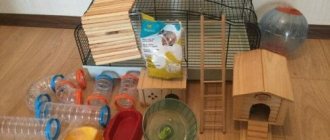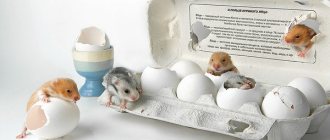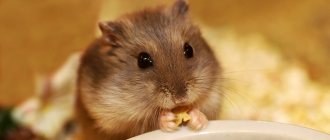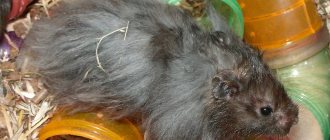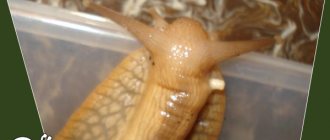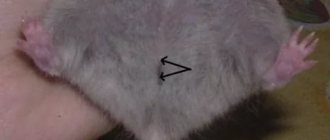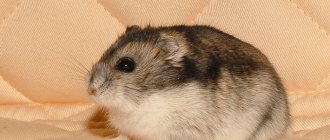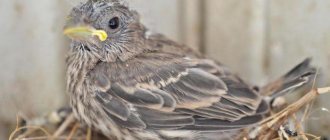- home
- Reproduction
14.07.2018
Djungarian hamsters differ from other breeds in character, habits and disposition. They prefer loneliness and cannot stand being around other rodents. Reproduction of Djungarian hamsters takes place under certain conditions.
How to keep a couple before mating: together or in different cages
Hamsters of this species reproduce well, and in captivity they are able to do this throughout the year. However, for this process they need to create certain conditions. So, before mating, it is better to keep the female and male in different cages, since they can show aggression towards each other - they will fight for territory. They need to be combined in one cage only for the duration of mating.
Note that peaceful coexistence of a boy and a girl in the same room is possible, but this is quite rare. If you do not have the opportunity to buy another cage, then you can place the female with the male for a while. Who knows, what if your couple will be on the list of those rare ones who live in peace and harmony. If the experiment fails, then it will still be necessary to decide to purchase a new cell. It is unlikely that you will like to put up with scratches and scraps of torn fur.
Read on for tips on choosing a cage and ball for your hamster.
You can avoid conflicts if you buy a girl and a boy at the same time and at the same time place them in a new cage. In this case, one male can even get along with several females. You should avoid placing a younger female with a male who has already been living with you for some time. In this case, war cannot be avoided.
Did you know? Experienced breeders have noticed that in a territorial war between males and females, the latter almost always win, and the males are inferior to them.
When to place rodents?
The sudden appearance of a cat next to hamsters preparing to mate, or an unexpected sharp sound can drive the animals into severe stress. They are capable of not only abandoning the task assigned to them, but also starting to fight. The mood of those getting married changes very quickly, regardless of their type. Fights can be so serious that one of the animals is severely injured or killed. Usually the strongest blows go to the male.
The following describes situations in which it is better to postpone mating of hamsters until better times:
- The girl initially did not like the male. In this case, you need to introduce the hamsters gradually or choose another boyfriend for your pet.
- The girl is not ready. If the hamster is not currently in heat, she will react especially aggressively to a furry man who appears nearby. Be sure that the lady will use not only her claws, but also her teeth. In such a situation, it is necessary to urgently remove the Djungarian boy and wait for the moment of estrus.
- Sudden fear. Due to stress, both hamsters can simply go wild and start fighting. In this case, their separation is necessary.
- The process is over. Not all hamsters, unlike individuals of the opposite sex, are ready to copulate all night. When the female decides that she has had enough, she will become restless and begin to show bouts of aggression. In this case, the partner should also be removed.
Sometimes hamsters can be left alone for half an hour to do their simple task. But you can leave only if the pets have established contact and they treat each other favorably. Still, it’s better to be nearby in case of a hamster force majeure. Usually the gentleman manages to inseminate the female within half an hour, then he can be separated.
In the photo copulating Syrians:
At what age do jungarians begin to mate?
Puberty in hairy hamsters occurs at 1-2 months. It is better to pair with a younger male and an older female. Ideally, the boy will be 3 months old, and the girl – 4. It is at this age that the female will be ready to take care of the offspring, and childbirth will become safe for her body.
If you still do not have information on how to determine the sex of hamsters, then you can do this already a month after birth. To do this, measure the distance between the animal's anus and genitals while lying on its back. If it is 0.5-1 cm, and in the center of the abdomen there is a small bulge - the male gland, then this is a male. Already at 2-3 months you will be able to see the testicles. If the distance is less than 0.5 cm, and there are 2 rows of nipples on the stomach, then it is a female. The female is also usually slightly larger than the male.
Important! A month after birth, females and males must be placed in different cages.
Puberty
1 month after birth, Djungarians reach puberty and are ready to mate. Veterinarians advise not to rush and let your pets grow a little more. Upon reaching the age of 3 months, you can start breeding dzhungarikas.
If you start breeding before the recommended age, the female will simply eat her offspring due to the lack of maternal instinct. The ideal age for first mating is 3-8 months. The older the female becomes, the less opportunity she has to reproduce. Therefore, you should not delay this (hamsters at the age of one year become pregnant extremely rarely).
How to understand that a female needs to be introduced to mating
She will indicate that the female is ready to mate by unusual behavior. Once every 4-5 days, she will often raise her tail, arch her back, and secrete a strong-smelling substance. This is how the female’s sexual activity will manifest itself, which, as a rule, coincides with the follicular stage of the sexual cycle. Scientifically, this process is called estrus, popularly called estrus. Estrus usually begins in the evenings and lasts from 4 hours to a day. At this time, the female becomes favorable to the male, so it is best now to unite them in one cage.
Pair selection
For breeding, one hamster of different sexes is purchased. To get a large number of offspring, you will need 1 male and several females. To get healthy babies, adhere to the following recommendations:
- Djungarians should not be related; hamsters are purchased in different stores.
- Interspecific crossing is avoided. This applies to dwarfs and Campbell's hamsters. They belong to the dwarf breeds and often produce quite viable offspring. But when crossing there are risks for the female, for example, a large fruit. In addition, hybrids are not valued by breeders and cannot be presented at exhibitions. In this case, some diseases of hamsters of the same breed are often transmitted to their offspring.
- The weight of an adult hamster ready for mating is about 40 g. Both future parents must be absolutely healthy. When purchasing, pay attention to the coat - in healthy hamsters it is clean and shiny, the eyes are bright, do not water, and the tail is dry.
To prevent accidental crossbreeding, hamsters are carefully examined when purchasing. Under the guise of Djungarians, both Campbell and Sungur hamsters are often mistakenly sold. It is quite easy to confuse them, especially when the animals are of a standard color.
The color of the dzhungarik is distinguished by an extended black stripe on the back and a peculiar diamond shape on the head. The eyes are always black, unlike other breeds.
There are unusual coat colors:
- sapphire (closer to gray-blue);
- red (more like tangerine);
- white with gray (pearl).
The offspring of such hamsters are valued by breeders. But in this case, you need to clarify all the nuances of genetics in advance:
- You cannot cross two “tangerines”, otherwise they will pass on the so-called lethal gene to their offspring.
- The offspring of pearl-colored hamsters will not survive either.
But you can experiment by breeding representatives of rare colors among themselves. Sometimes the offspring is quite interesting.
What conditions need to be created for successful reproduction?
To encourage hamsters to mate after uniting them under one roof, you should place a lamp in the immediate vicinity of the cage and direct the light from it into the cage. In this case, the animals will look for a dark corner in their home. This will certainly bring them closer.
The best option for mating would be a separate cage, carrier, or box . This way you can avoid conflict. If this is not possible, then the female is placed with the male, and not vice versa.
The mating cage should be spacious. The room temperature is not lower than 20°C and not higher than 25°C. The cage should be installed in a secluded place where there are no drafts, noise, heating devices, and away from other pets. It is advisable to remove all gaming accessories from it.
Find out more about hamsters: what breed of pet hamster to choose, how long do hamsters of different breeds live, how to train a hamster to respond to its name.
Do not abandon animals immediately after joining without supervision. If a serious fight breaks out, they will need to be seated. You can leave them alone only if it is clear that they like each other.
Since after conception the female will begin to build a nest, she needs to put materials in the cage - rags, cotton wool, clean paper, hay. Placing newspapers in the cage is strictly prohibited.
Pros and cons of breeding at home
Pros and cons of breeding Djungarian hamsters
Possibility of obtaining offspring of a rare color.
Experience for future veterinarians.
Difficulties with breeding. The female and cubs require appropriate care.
The arrangement of the offspring. It is better to breed hamsters if it has been decided in advance where the cubs will be placed.
No benefit. It often makes no sense to engage in breeding for additional income - ordinary dzhungariks are inexpensive. Maintaining offspring will cost more.
Not everyone breeds small dwarfs at home. Many people prefer to have pets of the same sex and not worry about the pregnancy of the hamster.
How do Djungarian hamsters mate?
Sexual intercourse among Djungarians lasts on average about 5 minutes. In general, the process of addiction and familiarization occurs within 20-30 minutes.
Djungarian hamsters usually mate in the dark. The male approaches the female several times with short breaks.
A couple should be placed in different cages when they have lost interest in each other. However, keeping them together for longer than 45 minutes is not recommended.
Do not worry if after mating the male lies down, barely breathing - sexual intercourse requires a lot of energy, so the animal needs time to recuperate. After mating, both the female and the male should be well fed with their favorite treats in the feeder.
Be prepared that it will take several matings to conceive . If 5 days after the first mating the hamster comes into heat again, the mating will need to be repeated. If estrus did not occur, and after some time the girl began to gain weight (usually the tummy becomes slightly noticeable after 10 days), then conception was successful.
Video: reproduction of Djungarian hamsters
Complications during childbirth
Complications can often occur during pregnancy, childbirth and afterward.
Toxicosis
Females experience toxicosis in the last days of pregnancy. There is no cure for this condition, but the consequences can be serious: the female and her cubs die during or after childbirth.
Death of fetuses in the uterus
If a mother gives birth to still babies, it means they died in the womb. This occurs due to poor nutrition, infections, age and physiological characteristics. If after this you do not undergo surgery to remove the uterus, the hamster will subsequently die from blood poisoning.
Pathology of childbirth
If labor is protracted, you should immediately consult a doctor. This situation occurs due to the age of females, whose pelvic bones become inelastic over time, due to the large size of the fetus.
Endometritis
The disease causes inflammation of the uterus, characterized by bleeding that lasts more than three days.
What to feed a pregnant female
A pregnant hamster needs to create comfortable conditions, ensure complete peace and absence of stress. Remember that stressful situations can have a detrimental effect on the offspring, even to the point of a distraught mother devouring her children.
The hamster should also be provided with good nutrition. At this time, her diet should contain a lot of fruits, vegetables and products containing protein, which is so necessary during the development of the offspring in the womb . The latter include:
- egg white;
- chicken meat (boiled);
- baby food with meat;
- dairy products.
Learn more about hamster nutrition.
Also, at this moment the female urgently needs to replenish her body with minerals. To do this, place a chalk stone in the cage.
Important! Good nutrition for the mother will guarantee that she will not bite the babies to death.
.
Pregnancy
Female Djungarian hamsters bear their offspring for 21-26 days. If pregnancy lasts longer, you should urgently show the animal to a veterinarian.
Signs
During the first 10 days after mating, it is very difficult to understand that the female is pregnant. Signs by which pregnancy can be determined:
- Activity decreases, sleeps longer than usual.
- Weight is added and the body becomes rounded.
- The estrus stops, the female no longer “walks.”
- Gradually begins to build a nest.
To build a nest, you can put cotton wool, clean rags, paper, and hay in the cage. It is not recommended to give newspapers; printing ink is dangerous for the female and future offspring.
Caring for a pregnant female
When bearing offspring, the female needs additional care. First of all, this concerns nutrition. Be sure to add more fruits, vegetables, herbs and protein foods to your diet. A lot of protein is found in chicken meat, baby food, and nuts.
To obtain the minerals necessary for the body, the Djungarian hamster is given a mineral stone. Also, sprouted grains are always added to the menu, and cottage cheese is made from dairy products.
The better the hamster's nutrition during pregnancy and after birth, the less likely it is that she will kill her babies.
How many hamsters are born to Djungarians?
A female Djungarian hamster is maximally capable of bearing 18 babies. Usually one individual has from 5 to 9 children.
Under no circumstances should you interfere with the birth process. It is better not to approach the cage at all, so as not to scare off the female. Childbirth lasts from 1 to 2 hours. The intervals between babies coming out are on average about 15 minutes.
Newborns are born tiny, bald and blind. Babies' eyes open after 2 weeks.
Offspring of Djungarian hamsters
A litter can contain from 1 to 11 cubs at a time. The mother feeds them with milk for about 19 days, then the babies can be resettled . Hamsters are born completely bald, blind and deaf. Among the senses, newborns have only smell, which helps them not to die of hunger. With proper care of the mother, the cubs do not make any sounds, and the pet owner may not even realize that there is already more than one hamster in the cage until she begins to crawl out of a secluded place on her own.
Care of offspring
After giving birth, the mother needs rest - at least for a week. After this time, she will again be ready to mate and conceive.
A nursing mother will need good nutrition and a constant supply of clean water . It is advisable to purchase special food at a pet store so that the hamster’s breast milk is as rich as possible in the vitamins and minerals necessary for the normal development of healthy offspring.
The cage where the babies are located must be spacious - at least 50 by 30 cm. The temperature in the room where the babies live must be maintained at 21-25°C . The house with newborns should be in a shaded, quiet place.
Thus, the owner must create all favorable conditions for the new mother, but not interfere in the process of caring for the babies.
If the mother nevertheless abandoned the cubs, then you need to try to feed them yourself. For this you will need baby formula. However, the chances of survival for abandoned babies are low.
Problems when breeding hamsters
Cubs can be born dead, die during childbirth, or become victims of a negligent mother.
Dead cubs can be born to a healthy female for the following reasons: infection, disease, poor nutrition, poor diet during pregnancy, lack of essential vitamins and microelements in food.
Often a pregnancy, especially the first one, ends with the hamster eating the babies. There are quite a few reasons for this:
- improper diet during pregnancy, in particular, insufficient amount of animal protein in the diet;
- the failed mother is too young;
- stress or fear after childbirth;
- in the cage where the hamster gave birth, there is a male who poses a threat to her babies, and therefore she directs aggression either at the male, and if this fails, then at the babies;
- regulation of the number of offspring (a female hamster has 5 or 6 pairs of nipples, and so many babies can be born that she will not be able to feed them all);
- if the baby was born weak, sick or with a birth defect;
- if a person picks up a small hamster in his arms in the first week after giving birth, which causes the baby to develop a foreign smell.
There is also a situation when the cubs die due to the excessive care of the mother, when, worrying about the safety of the offspring, she constantly moves the cubs in search of a safer place.
Babies can be born completely healthy, and yet die in the first week of life. This may happen due to the fact that the female is not able to fully feed her babies (insufficient amount of milk or its complete absence).
Poor nutrition, lack of drinking water, heat in the room where the cage with a pregnant female is located and stress can cause the death of a hamster just before giving birth or at the very beginning of feeding newborns. This condition is often called hamster pregnancy toxicosis. Signs of pregnancy toxicosis in females: lack or decreased appetite, dull and tousled fur, muscle spasms, and drooling.
Attempts to cure this problem are unsuccessful in most cases. Prevention is important here - providing the most comfortable conditions for a pregnant hamster (constant humidity and air temperature, absence of drafts, peace and quiet, as well as a properly formulated diet and access to fresh, clean water).
For some people, breeding hamsters is a business. Others conjure genetics, putting their soul into the nursery. Still others had no intention of breeding hamsters at all, but got offspring by accident.
Knowing at what age hamsters begin to mate, the breeder must have time to place the young animals in different cages according to gender.
The optimal period for the first mating is from 4 to 6 months. Second mating – 8-10 months (for the female). The animal is allowed to recover after birth for at least 2 months, and preferably 3-4 months.
Males retain reproductive abilities throughout their lives, and they can be bred as early as 5 weeks. But frequent mating is also undesirable - it exhausts the producer, and many females do not become pregnant after mating.
Is it possible to pick up small jungarians?
Experienced breeders do not advise touching or picking up babies until they reach two weeks of age. Also, until this time, it is worth climbing into the cage with your hands less often, only to carry out the necessary manipulations of replacing water and providing food. The litter is not changed at this time.
The most popular of all types of domestic hamsters is the Syrian; families with children love it.
The fact is that any careless actions can scare away the mother, and in this case she will stop fulfilling her parental responsibilities. There is a big risk that she will stop feeding the children if she smells someone else's smell on them.
Who are Syrian hamsters?
The animal is a mammal, an omnivore, and belongs to the hamster family. The Syrian or, as the breed is also called the Central Asian hamster, can eat food of both plant origin - seeds, nuts, and animal food - ants, wasps, flies. Recently, these animals have been kept at home. Rodents very quickly adapted to such conditions. The domestic Syrian hamster is active: it spins the wheel installed in the cage, climbs up the loopholes in it, and makes good contact with humans.
External features
The Syrian hamster is completely covered in fur, and the length and color depend on the genetics of the Syrian rodent. The coat color of the animal can be beige, brown, gray or black. In most cases it is uniform, but sometimes there are individuals that have spots in some places. The most common Syrian hamster is the shorthaired golden. Depending on the type and length of fur, rodents are divided into the following types:
- fluffy;
- short-haired;
- satin.
Dimensions
The rodent has a body with short legs, a small head, medium round ears and a small tail. The weight of a mature Syrian animal is 100-125 g; the length of an adult rodent, including a small tail and short muzzle, on average reaches no more than 13 centimeters. The animal has 5 short toes on its hind legs and 4 on its front legs.
Habitat
By the name of this animal you can understand where it comes from. In nature, these golden hamsters live in Syria, more specifically, in the vicinity of the city of Aleppo. The maximum number of these animals was recorded in this place. But they live not only in Syria: another place of residence of wild hamsters, according to some sources, is in eastern Turkey.
How long do they live?
Anyone who is planning to get Syrians often wonders how long Syrian hamsters live at home. If the animal is 3 years old, then it can be considered an old man. The lifespan of a rodent depends on its size and living conditions. Thus, wild hamsters often die or die a natural death before reaching 2 years of age. The average life expectancy of a rodent living at home is 2.5 years.
How to determine gender
It is best to find out whether a hamster is a boy or a girl from the 30th day. It is not recommended to handle younger individuals. To understand what gender a rodent belongs to, it is necessary to study the anatomical features of the animal, which include:
- Size of the individual. Females are larger than males.
- Back shape. In males it is pointed, in females it is more straight.
- Well-visible almond-shaped testes. Boys have clearly visible testicles in the genital area.
- Number of nipples. Females have 4, males have 2.
- A girl's excretory organs are located farther apart than those of a boy.
- The amount of fur in the genital area (males have more).
How to care for a Syrian hamster
Several times a week it is necessary to clean the cage: wash all the objects that the animal uses, put fresh bedding. The drinking bowl and food bowl should be rinsed every day. Special care for the Syrian hamster is not required, because he does it perfectly himself: he washes himself, cleans his paws and tail. In some cases, you can comb the fur. If necessary, it can be cleaned, but this must be done with a dry cloth or napkin.
You cannot bathe a hamster - this should be done in rare cases, because the animal does not tolerate water treatments very well. They can cause severe stress and colds
If you decide to bathe your hamster, do it very carefully. Here's what the bathing procedure should look like:
Carefully lower the animal into the water so that its face and ears do not get wet. Gently massage the fur in contaminated areas with your hands or a small sponge. Remove the animal from the water. Dry the rodent's fur with a hairdryer.
Syrian hamster cage
Any rodent must be kept in a specially designated place. It is best to place a golden hamster in a cage measuring 30 by 30 or 40 cm. The larger it is, the more comfortable the animal will feel in it. Give preference to houses with metal rods, the strength of which will need to be checked periodically. The cage should also have a wooden or plastic tray.
Read with this
- How to toilet train a dog using a diaper
- The hamster is chewing twigs in the cage: what to do?
- Everything you need to know about caring for budgies at home
- Tumors in a hamster: what are they and what to do with them?
- About clean people who are afraid of water
- Can your dog swim? Why Some Dog Breeds Can't Swim - Tips for Pets - 2020
- Water in the terrarium
- Correct selection and use of a walking ball for a hamster
- How to stop a dog from biting
- How to determine the sex of a hamster and why it is needed
When can you give away hamsters after birth?
Hamsters develop very quickly, so already at the age of one month they can be given into the wrong hands. Until the 21st day, they should be close to their mother. Then, no later than the 28th day, they should be removed. They must live in a separate cage for some time before being sold. The new owner should be given some bedding from the old cage and food so that the babies quickly adapt to an unusual place - a familiar smell and familiar food will reduce stress.
Selection and arrangement of the cage
There are special requirements for the selection and arrangement of the cage.
It should contain:
- "sports" zone;
- feeding area;
- shelters.
Many breeders also recommend installing a “dry” bath inside the cage. Rodents love to rub against sand to clean their fur and remove dead hairs during shedding.
Requirements
Djungarian hamsters are small, but they require a lot of space. The minimum size of the cage bottom is 55x30 cm. However, it is better to have twice as much space. You can buy a two-tier cage with metal bars. The pallet must be plastic or wooden. It is unacceptable to have a mesh on the bottom, because... getting a rodent's claw or finger into the cell will cause injury. It is desirable that the tray be removable.
The hamster cage should be as large as possible, at least 55x30 cm.
In the cage, you must install a resting house made of hay, special labyrinths and holes of different heights and shapes, as well as several snags under which the pet can retire or hide food.
Sports area
The hamster has a fast metabolism, so if the animal does not move a lot, its fat layer will begin to increase. Excess weight is extremely dangerous for the health of these animals.
In natural conditions, rodents travel up to 10 km a day, so it is important to properly set up a sports area in the cage. Hamsters love to run on wheels. Its diameter must be at least 16 cm. It is better if the wheel is solid so that the animal’s paws do not fall between the bars.
Eating area
The arrangement of the eating area also needs to be given special attention. As a feeder, you can use a metal container up to 2 cm deep. It is important that it is heavy enough. In this case, the animal will not be able to turn it over. Hanging plastic feeders are also convenient. They are attached to the bars of the cage, so the rodent will not be able to move them.
If the hamster receives succulent food every day, it is not necessary to install a container of water.
However, when eating dry grains, the animal may feel thirsty. It is better to install a mounted drinking bowl so that the rodent does not turn it over and wet the bedding.
Carrying and necessary accessories
For a hamster, a simple metal or plastic carrier with a length of at least 15 cm will be sufficient. This device is useful when visiting a veterinary clinic. In addition, you can place the animal here while cleaning the cage.
A hamster carrier is an important thing that you can’t do without.
The required minimum of auxiliary accessories includes a walking ball. While wearing it, your pet will be able to safely walk throughout the house. In addition, it is advisable to buy a teeth sharpener made from compressed grass.
Cleaning
Wood pellets or dry grass can be used as bedding. The filler layer should be at least 3 cm. A removable tray will make it easier to keep the cage clean. Every day you need to remove the remains of succulent feed. It is recommended to change the litter once every 2 weeks. Hamsters often only defecate in one corner. Only the contaminated part of the filler should be replaced. Preserved supplies and the smell of the animal remaining on the bedding will help the rodent avoid stress.
Why don't hamsters reproduce?
If, in the case of being kept together or having regular “dates,” the animals do not have offspring, there is usually a more reasonable explanation for this than “they didn’t like each other.”
Causes:
Same-sex animals
Even if the seller assured you that it is a boy and a girl, you need to carefully examine the crotch area and determine the sex of the rodents. It is often discovered that two males or two females were required to produce children.
Obesity
Excess weight is a common problem in Djungarian hamsters. Adipose tissue affects hormone levels and the female cannot become pregnant. Checking a dwarf pet is simple: when a fat animal sits, its paws are hidden under the folds, its stomach touches the floor when walking.
Insufficient diet
Unbalanced feeding and deficiency of certain vitamins disrupts reproductive function and also provokes cannibalism (the female eats the children).
Diseases
If a hamster has suffered a serious infection (pneumonia, enteritis), then the body will not be able to reproduce for a long time. You will not get offspring if the couple lives in conditions of constant stress: the sound of TV, drafts and sunlight, a cramped cage, an annoying cat.
Some aspects of mating
To avoid unplanned reproduction of hamsters, individuals of different sexes must be kept separately. The female should be placed with the male only for mating. These small rodents can reproduce between three and six weeks of age, and some species, such as the Djungarian, even earlier.
But you shouldn't mate hamsters at such an early age. This can adversely affect the female and her future offspring. The optimal age for mating hamsters is from three months to one and a half years, and the first mating must be made when the female is between 3 and 6 months old.
A certain period of time must pass between matings. The female needs to recover from pregnancy and gain strength for the next one. The most optimal period is three to four months. The second time the female can be mated is at 8-10 months of her life. Some individuals already lose their ability to reproduce at 12-14 months.
Males are ready for mating from the age of five weeks. They retain the ability to produce offspring throughout their lives. For mating of these rodents, not only age, but also the individual of the opposite sex matters.
We talked about how to choose a mate for a hamster in this article.
What newborn babies look like
Hamsters are born blind and hairless.
On the first day of life, babies are red, then they turn pale.
The weight of newborns is 2-3 g. The first fluff on the body will appear in about 7 days.
The first fur on the hamster's body appears only after 7 days.
In a large and interesting article about Djungarian hamsters, I discuss issues such as feeding Djungarian hamsters, their onset of sexual maturity, mating and offspring of Djungarian hamsters. I will also tell you about the necessary things in a cage with
A few words about the kids
Newborn hamsters develop quickly and learn about the world. But for the first week they do not leave the nest at all, feeding on the milk of their furry mother. Breastfeeding lasts from birth to 3 weeks. During this period, it is better not to touch the animals, because a hamster may lose milk due to stress, and an angry mother in labor may abandon her babies altogether. In this case, you will have to feed the hamster offspring yourself, and many of the babies will die.
To prevent this problem from arising, provide the family with peace for the first 2 weeks. The bedding is also not changed during this period, but only a little food is added. At one week of age, babies begin to crawl blindly around the cage. And already at the age of 2 weeks they open their eyes. Around this period, complementary foods consisting of low-fat yogurt and peeled seeds should be introduced.
At 3 weeks, babies are already covered with thick fluff and can eat on their own. This means that it is time to remove them from their mother. Watch the babies for another week, and already at the age of 1 month you can give the miniature animals to new owners.
If you decide to keep the kids for further breeding, then at the same age determine their gender and place the boys and girls in different cages. This precaution will not allow the reproduction of small rodents to take its course.
There are many nuances in the reproduction of hamsters. You need to remember that mating of animals must be timely, voluntary and safe for both participants. At the slightest sign of aggression, separate the animals from each other! An important aspect of reproduction is the gestation period. In this position, the pet needs absolute rest and increased nutrition.
Source
Breeding cycle
Pregnancy lasts about three weeks. You can bring a female and a male together only during the period of estrus, which occurs every 3-5 days, usually in the evening. At this time, Syrian hamsters secrete mucus from their genitals and a special musky odor appears, which attracts the male.
It is quite difficult to detect any physiological changes in dwarf breeds, be it Djungarian or Roborovsky. However, you can guess that the female is showing readiness to mate by her changed behavior.
She loses her appetite and stands motionless, with her paws spread wide and her back arched. During this period, the hamster reacts favorably to the approach and courtship of the male.
Pregnancy in animals lasts 16-21 days, in dwarf breeds - 22-24 days. After this time, from 5 to 12 cubs are born; they have no fur and weigh only 2-3 grams.
However, the hamsters already have teeth, after a week tiny fur appears on the body, and the most active babies can crawl out of the nest.
Experienced breeders advise breeding hamsters no more than 3 times a year. More frequent mating wears out the hamster's body, and the male loses the ability to fertilize.
